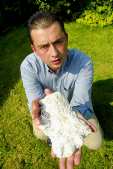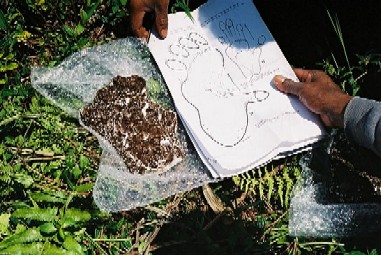Expedition: New Orang Pendek Discovery
Posted by: Loren Coleman on September 20th, 2007

Adam Davies is shown with a 2004 cast of an Orang Pendek track. Courtesy BBC News. Davies has good news from his latest expedition efforts in search of this hidden primate.
Adam Davies has returned from his pursuit of the Sumatran Orang Pendek, having been gone from September 2 through his return today. In conjunction with a History Channel documentary, Davies was there with British photographer Jeremy Holden, who has worked with Debbie Martyr in the past.
Davies just back from the rainforest, forwards his quick update to me:

The expedition was a huge success. I picked up an Orang-Pendek trail and we made some excellent prints, all of which the History Channel filmed. I and my chief guide Sahar, also picked up bear and golden cat tracks, and some tiger kills – a deer and a boar skull.
The prints are special in that they will show how the creature moves (e.g. how the hallux [big toe] twists in response to movement and how its weight is distributed whilst walking). The prints collected may also contain dermal ridges! I didn’t clean them in the jungle, as I wished to maintain the evidence. The casts have been left with the History Channel to be analysed scientifically (maybe they’ll ask your friend Jeff Meldrum to be involved?).
I’ve requested for the casts to be returned to me when they are done. I don’t need to tell you that this will be something of a world first, as it is clearly unique evidence. Jeremy reinforces this point to the camera and it is all filmed by the channel on location. The prints are also very similar to the one you’ve got a copy of [from the previous Orang Pendek expedition].
BTW, the earthquakes were a sight to behold. I was on top of Gunung Tujuh when the first one hit – the ground seemed to turn to liquid. All the birds went mad, the lake pitched, and being volcanic, bubbled rather worryingly!
Down in Padang, I saw a few of the collapsed buildings, and learnt that a lot of people had been sleeping in tents outside, afraid of their houses falling on them.
This History Channel documentary will be special. It felt very dramatic at the time [in the field], and I’m sure it will look great when the programme airs.Adam Davies, September 20, 2007.

The following are other photographs from the past explorations to Sumatra by Adam Davies and Andrew Sanderson.
The rather specific Orang Pendek track they have found, photographed, and cast, shows toes at the end of the foot and something out to the side, which may be from another toe, the hallux (which would be typical for a pongid).

The Extreme Expeditions pages show the obtaining of the 2004 cast in Sumatra, on their pages 13 through 15. They also show where and how they obtained the 2001 cast (below) here, the original that was on display at Bates College (of which I now have a first-generation copy).
Please click on the image for a larger version.
Please click on the image for a larger version.
About Loren Coleman
Loren Coleman is one of the world’s leading cryptozoologists, some say “the” leading living cryptozoologist. Certainly, he is acknowledged as the current living American researcher and writer who has most popularized cryptozoology in the late 20th and early 21st centuries.
Starting his fieldwork and investigations in 1960, after traveling and trekking extensively in pursuit of cryptozoological mysteries, Coleman began writing to share his experiences in 1969. An honorary member of Ivan T. Sanderson’s Society for the Investigation of the Unexplained in the 1970s, Coleman has been bestowed with similar honorary memberships of the North Idaho College Cryptozoology Club in 1983, and in subsequent years, that of the British Columbia Scientific Cryptozoology Club, CryptoSafari International, and other international organizations. He was also a Life Member and Benefactor of the International Society of Cryptozoology (now-defunct).
Loren Coleman’s daily blog, as a member of the Cryptomundo Team, served as an ongoing avenue of communication for the ever-growing body of cryptozoo news from 2005 through 2013. He returned as an infrequent contributor beginning Halloween week of 2015.
Coleman is the founder in 2003, and current director of the International Cryptozoology Museum in Portland, Maine.












Those prints look somewhat similar to an orangutan’s foot, although eyewitnesses clearly describe something different from an orangutan.
Has there been much analysis comparing the casts to the fossil record? Anything in the record that is close to the foot anatomy?
very informative new update article about the orang pendek discovery. very interesting.
Thanks for passing this along, Loren. I find myself cautiously looking forward to the History Channel program and the results of the analysis. Perhaps for once we’ll actually learn something concrete?
Kool. Little Foot lives. (That’s what I call em) That cast is no bigger than a human hand. Puts this Little Foot about 4-5 ft tall I would guess.
Wow, that is a real print, or at least, it has features that others from North America do not have that incline me to think it genuine. The same can be said for the earlier cast.
I don’t know if I should say what because of hoaxing.
It would be very helpful to compare with Orang Utan prints.
I take it they didn’t track the critter down? Or see any orang utans in the trees?
Why is it that the vegetation and leaf litter is missing from the print location as shown in the photo? It doesn’t look natural to me.
“Or see any orang utans in the trees?”
No orangutans would be expected in the trees there. Orangutans, specifically, the rare Sumatran orangutans are only found in the north of Sumatra. The Orang Pendek are found in the south.
“Why is it that the vegetation and leaf litter is missing from the print location as shown in the photo?”
Remember, we are talking about a past encountered footprint there. Not the recent one. The one shown was “prepared” for casting and being filmed for the television documentary. While none of us would do this in the field, for “good television,” such things do happen after the initial findings are often recorded.
In other words, footprints found on many occassions are covered in leaf litter or pressed through material on the jungle floor, but for documentary film reasons, the vegetation is cleared away for photographic reasons. This does not make the track faked, although it is disturbed. It might not be the way any of us might do it, but if one of the objectives of the mission is to make a documentary, various extraordinary events do occur to accomodate the filmmaking.
You must remember that in the early days of Bigfoot field studies, the Bigfooters would only keep the best looking footprints, ignoring the ones that showed movement in the foot. Also, Bob Titmus use to “clean” the casts after they were taken, so the surfaces would look attractive, smooth, and white. Can you imagine what an outcry that would cause today?
Finally some concrete evidence of a creature perhaps unknown to science. Equally good was Adam Davies’ comments on earthquake effects.
I’m actually pretty impressed with the print I see here. It is not so clear as to indicate a hoax, yet it is not seemingly a random hole in the ground. It is not spectacular looking, but it looks very much like an actual print that a real creature would leave. The toes are hinted at yet they are definitely there whereas if this was a hoaxed print, I would expect more toe differentiation to show up in a bid to put more use to the prosthetic. If the speculation about the flexible big toe is further corroborated, I’d say this is a very promising find.
Good points mystery man. This is some pretty compelling evidence. Most tracks of wild animals usually are not as pristine as they show up in the guide books. If this had been an absolutely perfect print, I’d be more skeptical. But this one still has some detail and an authentic look to it. Malaysia has some thick rain forest, but it is being logged off rapidly. This makes eventual discovery of an Orang more likely, but is also a harbinger of its extinction as well.
Could a mostly bi-pedal animal walk in the manner that is being described? I would think this would not be a very efficient method of moving, so wouldn’t survive the trials of evolution.
Orang utans are only -known- to be in the north. The relationship between the known orang utans and orang pendek remains an unknown. Or do we have DNA sequencing and skeletons I don’t know about?
1. We don’t -know- what made the tracks.
2. We don’t -know- significant details about the orang pendek.
3. Orang utan might have made those tracks, or has that been disproven?